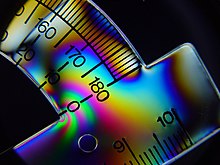
Back إجهاد (ميكانيكا) Arabic Tensión (mecánica) AST Gərginlik (mexanika) Azerbaijani Spaunnung BAR Механічнае напружанне Byelorussian Мэханічнае напружаньне BE-X-OLD Напрежение (механика) Bulgarian পীড়ন Bengali/Bangla Mehanički napon BS Tensió (mecànica) Catalan
This article needs additional citations for verification. (August 2021) |
| Stress | |
|---|---|
 Residual stresses inside a plastic protractor are revealed by polarized light. | |
Common symbols | σ |
| SI unit | pascal |
Other units | psi, bar |
| In SI base units | Pa = kg⋅m−1⋅s−2 |
| Dimension | |
| Part of a series on |
| Continuum mechanics |
|---|
In continuum mechanics, stress is a physical quantity that describes forces present during deformation. For example, an object being pulled apart, such as a stretched elastic band, is subject to tensile stress and may undergo elongation. An object being pushed together, such as a crumpled sponge, is subject to compressive stress and may undergo shortening.[1][2] The greater the force and the smaller the cross-sectional area of the body on which it acts, the greater the stress. Stress has dimension of force per area, with SI units of newtons per square meter (N/m2) or pascal (Pa).[1]
Stress expresses the internal forces that neighbouring particles of a continuous material exert on each other, while strain is the measure of the relative deformation of the material.[3] For example, when a solid vertical bar is supporting an overhead weight, each particle in the bar pushes on the particles immediately below it. When a liquid is in a closed container under pressure, each particle gets pushed against by all the surrounding particles. The container walls and the pressure-inducing surface (such as a piston) push against them in (Newtonian) reaction. These macroscopic forces are actually the net result of a very large number of intermolecular forces and collisions between the particles in those molecules. Stress is frequently represented by a lowercase Greek letter sigma (σ).[3]
Strain inside a material may arise by various mechanisms, such as stress as applied by external forces to the bulk material (like gravity) or to its surface (like contact forces, external pressure, or friction). Any strain (deformation) of a solid material generates an internal elastic stress, analogous to the reaction force of a spring, that tends to restore the material to its original non-deformed state. In liquids and gases, only deformations that change the volume generate persistent elastic stress. If the deformation changes gradually with time, even in fluids there will usually be some viscous stress, opposing that change. Elastic and viscous stresses are usually combined under the name mechanical stress.

Significant stress may exist even when deformation is negligible or non-existent (a common assumption when modeling the flow of water). Stress may exist in the absence of external forces; such built-in stress is important, for example, in prestressed concrete and tempered glass. Stress may also be imposed on a material without the application of net forces, for example by changes in temperature or chemical composition, or by external electromagnetic fields (as in piezoelectric and magnetostrictive materials).
The relation between mechanical stress, strain, and the strain rate can be quite complicated, although a linear approximation may be adequate in practice if the quantities are sufficiently small. Stress that exceeds certain strength limits of the material will result in permanent deformation (such as plastic flow, fracture, cavitation) or even change its crystal structure and chemical composition.
- ^ a b "12.3 Stress, Strain, and Elastic Modulus - University Physics Volume 1 | OpenStax". openstax.org. 19 September 2016. Retrieved 2022-11-02.
- ^ "Class Physical-Quantity in theory Physical-Quantities". www-ksl.stanford.edu. Retrieved 2022-11-02.
- ^ a b "What is Shear Stress - Materials - Definition". Material Properties. 2020-07-31. Retrieved 2022-11-02.

